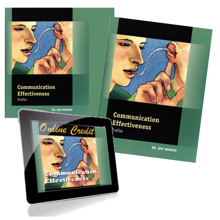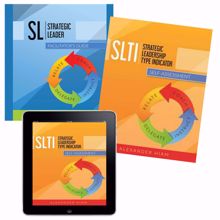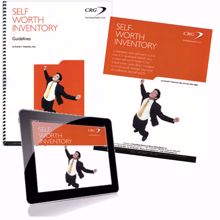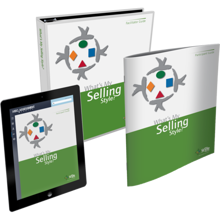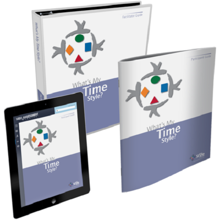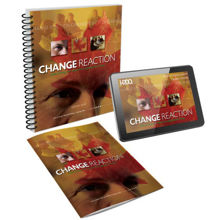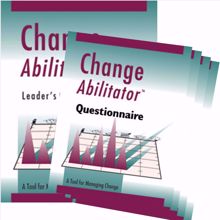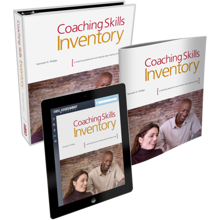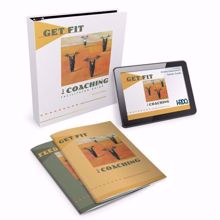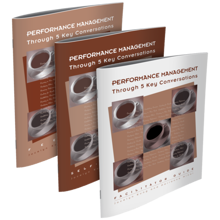Assessments
Communication Effectiveness Profile
Most of us take the art of Communication for granted
We each take part in dozens of conversations every day so it ought to be something we're good at! Shouldn't it? Yet the truth is that most of us are not as good at two-way communication as we think. The Communication Effectiveness Profile can change that.
Our ability to communicate effectively shapes and determines our personal and professional success. It will affect our self-esteem and our sense of well-being, and the contributions we make to our families, our jobs, and our communities. Poor communication can even affect our health.
Successful communicators can be made as well as born, effective communication is based on several fundamental principles—common sense, really. Using Communication Effectiveness Profile means understanding these basic skills and then practicing and refining them to become effective and influential communicators.
Strategic Leadership Type Indicator
The Standard in 4-quadrant Leadership Assessments
The Strategic Leadership Type Indicator assessment process is a complete development cycle for supervisors or leaders:
Complete a self-assessment and discover preferred leadership strategies for a variety of contexts...and how to select the most appropriate. Then use these strategies to develop direct reports, and move them toward higher autonomy, competence, and improved productivity.
You'll appreciate its simplicity, combined with ample support materials and without burdensome and expensive certification requirements. Managers and supervisors will like the emphasis on learning the appropriate use of four different management styles. The SLTi helps build the coaching style widely considered the most flexible and motivational for today's leaders.
Self-Worth Inventory
Increase Your Confidence and Motivation at Work & Socially
We all have various levels of self-worth. In the past, discussion about a person's self-worth was taboo and certainly not encouraged. The Self-Worth Inventory (SWI) is a simple yet powerful process to help measure your levels of self-worth in specific areas of your life. The SWI does not create self-worth; it confirms what is already true.
Reduce the negative impact that events have on an individual's self-worth levels. This can be achieved by a better understanding of situations and specific approaches for maintaining and increasing self-worth levels. Many organisations and individuals use the Self-Worth Inventory on a regular and planned basis
What's My Selling Style?
Sell better! Sell More!
What makes one salesperson successful and another unsuccessful?
Popular books target characteristics such as ambition, initiative, self-confidence, tact... the list goes on. The common thread? Personality! Whether or not salespeople are aware of it, their personality shines through every interaction.
What’s My Selling Style helps individuals analyse how they typically behave in a sales situation, identify their customers’ styles, and learn how to adjust their own style to match their customer. With increased awareness and flexibility, salespeople can use style to maximise sales and rise above the competition.
What's My Time Style?
Learn the Time Management Style that Suits you Best
Time management is very personal and the best approach varies for all of us, the What’s my Time Style? enables participants to identify what works best for them. Ideal as a stand-alone module or as part of training programmes such as Facilitating; Leading Meetings; Team/Project Management.
Change Reaction
Managing Individuals Responses to Organisation Change
Change can be a very uncomfortable experience even when we recognise its necessity.
Understanding our own reaction is an important first step to dealing with it. Change Reaction is an effective tool for understanding an individual’s attitude to change, and identifying ways to manage it better.
Mastering the Change Curve
Helping organisations to change smoothly!
If the individuals in your organisation are having a difficult time adapting and adjusting to organisational change, Mastering the Change Curve is your remedy!
It's an easy and effective change management assessment guide for bringing issues to the surface, providing a framework for healthy growth, and empowering individuals to shift their focus from the past to the future. Mastering the Change Curve is appropriate for individuals at any organisational level who are experiencing continuous change. The most appropriate target audience consists of individuals who are subject to change they did not initiate themselves.
Leading Change at Every Level
Leading Organisational Change
Whether you’re in the midst of a change effort or just planning one, you’ll need Leading Change at Every Level. Created for all organisational levels, this diagnostic tool drives home the importance of individual behaviour to the success of an overall change effort.
Change is here to stay; in today's empowered workplace what was once the role of senior management is now the responsibility of individuals throughout the organisation; from the executives at the top of the pyramid to the frontline employees at the base.
Leading Change at Every Level is the combination self-assessment and training workshop that measures skill level and develops the five behaviours of effective change leaders, those people who can effect how change is received at every level!
Change Abilitator
Better Understand Staff Concerns About Change
A key strategy for managing and implementing change is to fully understand the concerns, including the subliminal and things that people may not want to openly admit. By more fully understanding the challenges it is possible to deal with them in an appropriate fashion and overcome them.
The questionnaire identifies these and other issues It can be used over time to measure progress and also averaged over a group to identify collective concerns.
The Leaders Guide establishes the Stages of Concern, and gives useful tools and approaches for dealing with each of them including “lesson” plans. The Leaders Guide is intended for Managers, Supervisors, Team Leaders HR Managers and Change Managers. It gives an understanding of how the questionnaire works, and some practical methods for using Change Abilitator.
Coaching Skills Inventory
Add excellent coaching to your armoury
If you think performance issues will magically vanish into thin air, think again!
Are managers having multiple performance conversations with employees about nagging issues – with no apparent effect? Or maybe the manager can’t see solutions to a problem and ignores it altogether. And then there's the control freak who likes to chew out employees when their performance isn't up to snuff. Unfortunately, these types of scenarios occur far too often in the workplace and they're a lose-lose predicament for not only the employee and manager, but the organisation as well.
There is a solution for these situations; the Coaching Skills Inventory is based on sound proven principles. The steps and skills involved are those that mark out the best coaches from the rest! The Inventory identifies strengths and weaknesses, provides a model for more effective coaching meetings, and enables before and after measurement of progress.
Get Fit For Coaching
A complete fitness programme for coaches
Effective coaches equate to stronger leaders, more motivated employees, improved morale, and better communication in the workplace. So what does it take to become great?
There are many skills and attributes of an effective coach. Get Fit for Coaching identifies and assesses areas of strength and improvementin 5 critical skills Building Rapport, Observing and Analysing, Questioning and Listening, Providing Feedback, and Facilitating Learning.
Get Fit for Coaching is appropriate for managers, supervisors, and team leaders at all levels. It can be used as a stand-alone assessment or debrief, an icebreaker for new coaches or individuals new to management, or as part of a comprehensive training programme on leadership development.
Performance Management Through 5 Key Conversations
The 5 conversations every manager concerned with performance should be having!
Performance Management Through 5 Key Conversations helps managers identify their skill level in engaging employees in the 5 key types of performance-related conversations, enabling managers to create a profile of skill level in each of these Conversations and providing insight on the areas for improvement.
Good conversations facilitate the development of high-performing employees through collaborative and constructive dialogue; engage employees in meaningful, performance-related conversations, to build relationships and get results in a less awkward, more productive atmosphere.
Performance Management Through 5 Key Conversations is effective when used alone or as part of a management development programme. The instrument can be used to establish a new approach, to performance management in an organisation, or to provide basic skills for new managers or supervisors. It is also useful when used to suggest an alternate or complementary approach to existing techniques.
